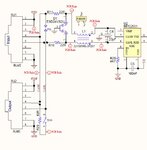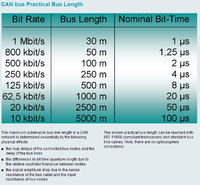llima
Newbie level 4
Hello,
I have a project were several boards connect to each other using a CAN bus, however, I am having problems with the can physical layer.
If I add more than three nodes, they stop comunicating.
I discovered that if I add terminator resistors in each node, lowering this way bus impedance, they restart comunication but this should not be necessary. Also, the signal gets attenuated along the bus.
I also discovered that if I lower the bus speed, I can add two more nodes without having problems.
The hardware was not designed by me, but now I have to solve this problem, so I ask for your help
Below is an image of the circuit between the can transceiver and the can bus.
- Each node has two rj45 connections, to allow for the adding of more nodes
- We use UTP cat 5 cable for the connections, and we use one of the pairs for the CANL and CANH lines
- The power supply for each node is provided by the bus it self, using the other wires of the RJ45 connector
- Each node has a switch to turn on or off the bus termination resistor
I am suspitious ot the filtering and protection circuit that you see in the image, because we have an older version of these boards were the transceiver was connected directly to the bus(rj45 conectors) and we did not have this problem
One test I have already done is removing and short-circuiting the r11 and r16, and replacing the r29 with one of 120r, but there is no change in the nodes behaviour
thanks in advance for your help

I have a project were several boards connect to each other using a CAN bus, however, I am having problems with the can physical layer.
If I add more than three nodes, they stop comunicating.
I discovered that if I add terminator resistors in each node, lowering this way bus impedance, they restart comunication but this should not be necessary. Also, the signal gets attenuated along the bus.
I also discovered that if I lower the bus speed, I can add two more nodes without having problems.
The hardware was not designed by me, but now I have to solve this problem, so I ask for your help
Below is an image of the circuit between the can transceiver and the can bus.
- Each node has two rj45 connections, to allow for the adding of more nodes
- We use UTP cat 5 cable for the connections, and we use one of the pairs for the CANL and CANH lines
- The power supply for each node is provided by the bus it self, using the other wires of the RJ45 connector
- Each node has a switch to turn on or off the bus termination resistor
I am suspitious ot the filtering and protection circuit that you see in the image, because we have an older version of these boards were the transceiver was connected directly to the bus(rj45 conectors) and we did not have this problem
One test I have already done is removing and short-circuiting the r11 and r16, and replacing the r29 with one of 120r, but there is no change in the nodes behaviour
thanks in advance for your help

Last edited:
